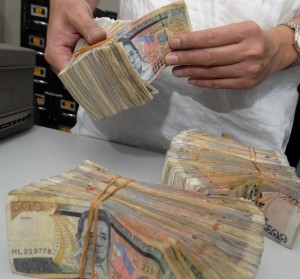Banks warned of rising credit growth-related stress

A bank teller prepares stacks of P500 denomination for the bank’s automated cash dispenser in this file photo. Fitch Ratings said the exposure of the Philippine banking sector to risk of failure due to excessive lending remained low, but warned of the threat of a rising credit growth-related stress for banking sectors in the Asia-Pacific region. AFP PHOTO/ROMEO GACAD
Fitch Ratings said the exposure of the Philippine banking sector to risk of failure due to excessive lending remained low, but warned of the threat of a rising credit growth-related stress for banking sectors in the Asia-Pacific region.
In its latest report on Asia-Pacific, Fitch said the credit story in the Asia-Pacific was very much different from that of developed countries in the West. While credit growth is slowing down in advanced economies, it has been accelerating in Asia-Pacific by a pace fast enough to cause concern.
Given enormous liquidity enjoyed by banking sectors in Asia-Pacific countries, including the Philippines, Fitch said there must be some forms of control on credit growth in the region to ensure this was kept within prudent limits.
“Fitch believes that above-trend credit growth in tandem with booming property and equity markets remains the most reliable early-warning indicator (of system-wide risk for banks), particularly in countries where regulatory forbearance is prevalent,” Fitch said in the report titled “Asia Pacific’s Banks Rising Leverage Highlights Concerns.”
The credit watchdog said the latest macroprudential index (MPI) for the Philippines stood at “1,” which indicated low risk of system-wide stress preceded by rapid credit growth and asset price bubbles.
An MPI of “2” indicates moderate, while “3” means high risk.
Asia-Pacific countries that obtained the same comfortable MPI index for their banking sectors as that of the Philippines were Malaysia, Taiwan, Thailand, South Korea, Japan, India and New Zealand.
Fitch, however, said several countries in the region had an MPI of “3.” These are China, Hong Kong, Indonesia, Mongolia and Sri Lanka. These countries, it said, must immediately implement measures to arrest the worrisome pace of credit growth.
A credit growth that has been consistently faster than the growth of the economy or one that pushes outstanding loans of banks to exceed deposits is considered worrisome, it said.
In the meantime, countries in the region that are in the moderate risk category, or those with an MPI of “2,” are Australia, Vietnam and Singapore.
Since last year, Philippine banks have been posting double-digit growth in outstanding loans. The total loan portfolio of universal and commercial banks in the country hit P2.88 trillion as of the end of May, up by 14.7 percent from P2.51 trillion a year ago. This rate of growth led many to believe that the country was in the early stage of a credit boom.
However, Fitch said the case of the Philippines was much less worrisome if compared with the other countries in Asia-Pacific.
Although credit is growing significantly in the Philippines, deposits are also on the rise. As a result, the loans-to-deposit ratio for the Philippine banking sector remains at a relatively comfortable level of 58 percent, according to Fitch.
Moreover, the credit-to-gross domestic product (GDP) ratio in the Philippines remains below 50 percent compared with the over 150 percent for China and the over 200 percent for Hong Kong.
Excessive lending, especially one that is not accompanied by growth in deposits, makes banks prone to the risk of default and to probability of liquidity problems. Failure of the banking sector usually drags the growth of an economy.